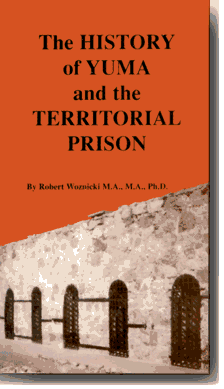
|
xii + 212 pages, including index and bibliography
ISBN 0-933025-35-1
Woznicki Publications, Tempe, Arizona
Table of Contents
Preface
Prologue
01. Some Interesting Facts about Yuma, Arizona
02. Early Yuma . . . the Spanish Period
03. Early Yuma . . . Continued
04. Steamboats on the Colorado
05. The Real Yuma Begins to Grow
06. Yuma from 1900 to World War II
07. Gadsden Purchase and Its Effect on Yuma
08. Yuma Indians
09. Fort Yuma
10. Yuma Territorial Prison
11. The Railroads of Yuma County
12. The History of Irrigation in Yuma County
13. The Colorado River
14. The All American Canal
15. Roads in the Desert
16. The Catholic Church in Yuma
17. U.S. Marine Station and the Yuma Proving Grounds
18. The First Hanging in Yuma
19. Sylvester Villa
20. More Facts about Yuma
21. Agriculture
22. Yuma of the Future
23. Famous Men of Yuma
24. Somerton, Arizona
25. Harold C. Giss
26. Points of Interest around Yuma County
27. San Luis, Arizona
Bibliography
Index
From Chapter 5, "The Real Yuma Begins to Grow"
The years 1858 and 1859 were important ones in the Yuma area. They brought permanent residents, a new steamer, and the discovery of gold on the Gila. Many Americans and Mexicans who returned from California were frustrated because they did not find gold, and they stopped along the areas of Yuma Crossing and hunted for the rich, yellow lode. Jacob Snively, a man from Texas, found the dust about eighteen miles above Fort Yuma. News spread all over the United States, and for a while, the Yuma area was a repetition of the California gold strike. The area where gold was found by Snively became Gila City, and about a thousand people suddenly appeared to make the city a new hub of activity. . . . The gold strike did not last long. There was no rich discovery of any kind. The settlement soon vanished, and Gila City became a ghost town. In 1862, Arizona City [Yuma] suffered a severe flood. At this time the Gila River overflowed her banks to such an extent that water stood twenty feet deep on a ranch in the bottom lands just above the town. The town virtually had to be rebuilt again. This was one of many disasters that the future area of Yuma was to suffer. In 1864, Yuma County was laid out with La Paz as the county seat, and it was in this year that the first Pony Express came to Yuma. But in 1867, Yuma, as we know it, began to mature as a site. Permanent homes replaced huts; there were streets and new stores. Mexicans came from Sonora and many came from California. The rich soil near the river produced abundant crops. Wagon factories were established to take care of the overland freighters. In 1866, the Post Office was established, and the Arizona Vigilantes organized. In 1870, Arizona City was made the county seat of Yuma County. Consequently when the San Diego [California] tax collector arrived the following fall, there was trouble. When he demanded that the taxes be paid in gold coin, an excited citizen swore out a warrant charging the man with an attempt to collect money under false pretenses. Fortunately for him, some of the more calm citizens deposited bail for his temporary release to appear in court. Immediately the troubled man wrote to San Diego to inquire what action he should take. His friends advised him to leave the place under cover of darkness. No time was lost in doing this, and his bondsmen were left in a bad state of mind. All of them declared they would never pay another cent to the San Diego authorities, and from that time on the citizens of Yuma have carried out their threat. History seems to record the fact that the people of Yuma always wanted to be identified with the great area known as Arizona. Copyright © 1995 by Robert Woznicki. |